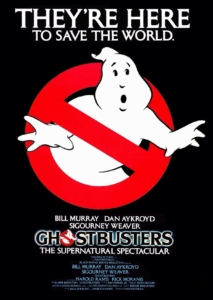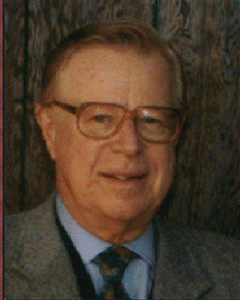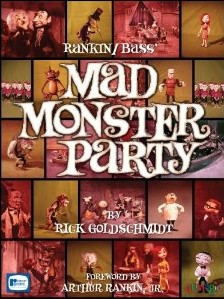Arthur Rankin, Jr. is part of the duo team Rankin/Bass. He is a legend and does not need any introduction. Rankin/Bass created the timeless holiday specials “Rudolph, the Red-Nosed Reindeer”, “Frosty the Snowman”, “The Year Without Santa Claus” and “Santa Claus is Coming to Town”, just to name a few. Media Mikes had a once in a lifetime chance to chat with Arthur about his work and how it has and will continue to entertain generation after generation. This interview originally was posted March 2012 but I wanted to revisit this post for the holiday season!
Mike Gencarelli: Let’s start with “Rudolph, the Red-Nosed Reindeer.” Why do you think this special has become timeless after almost 50 years?
Arthur Rankin, Jr.: I really don’t have an answer to that. I think because it was the first special of its kind…I think that, in looking for something to watch for Christmas, parents put their children in front of the television. And the word went out that this was a nice show, etc., etc, etc. and so next year it had a bigger audience. And as the audience grew, so did the children that watched it. They grew up to become mothers. And they grew up to become grandmothers! And they also put their children and grandchildren in front of the television set. That’s been going on for all of these years. It’s a pattern. That’s why Disney keeps re-releasing it’s old pictures. Because there’s an audience. The theatre may have a child whose having his first experience with the film while his grandmother is having her fourth or fifth experience with it. And that’s what our audience consists of. It’s a memory of life. To many people, “Rudolph” means Christmas.
MG: Why did you choose to work with stop motion animation, which you refer to as “animagic,” as opposed to conventional animation?
AR: A trade delegation had come to America from Japan. There was one gentleman who represented the steel industry…another who was in textiles. And a third who represented their motion picture industry. The motion picture representative had a studio he wanted to promote. He asked a friend of his in Washington D.C. if he could be introduced to one of America’s foremost animators. And by mistake he was led to me (laughs). We got along very well. He had been born in the U.S. and after he graduated college he went back to Japan. We became close friends. He invited me to come over, look at his studios, and tell him what I thought. I did. I went over, toured the studios and saw an example of stop motion, which hadn’t been done in a long time and not in any great depth. I was very taken by it…I thought it was a new approach. Of course I got to re-design it but I used the technique. We started out making some short films and they turned out very well. I made a series that I syndicated about Pinocchio. And then Rudolph the Red-Nosed Reindeer lit up his nose. I lived in Greenwich Village at the time and my neighbor down the block (Johnny Marks) had actually written the song. I called him up and told him that there was a character there that would make a nice Christmas show. He was reluctant to do it at the time – do you know what ASCAP is? (NOTE: ASCAP is the American Society of Composers, Authors and Publishers. It is through this group that songwriters earn their royalties). “Rudolph” was a very successful song at Christmas time and he was afraid to jeopardize that income by doing anything with the song. I finally convinced him that the show would promote the song more. I took my idea to General Electric and they sponsored it. They put it on NBC for the first time in a spot they had used for “The College Bowl” – Sunday afternoon at 4:00. (NOTE: “The General Electric College Bowl” could best be described as the collegiate version of “Jeopardy.” It ran on NBC from 1959-1970). Now normally no one is watching television on Sunday afternoon at 4:00 but they were that day…”Rudolph” earned the highest rating of the week. And the rest is, “let’s have some more of those!”
MG: Your next Christmas project was “Frosty the Snowman,” which took a more traditional animation route. Why not stop motion?
AR: Because the subject lent itself better to the medium. Besides, by then I had several other films in production at my studio in Japan. I had no more room! We were into doing a feature in stop motion.
MG: You created so many great specials over the years. One of my favorites is “The Year without a Santa Claus.” Can you share any fun stories from that production?
AR: There’s a man who wrote a book about the motion picture industry. He said, “Remember one thing…nobody knows anything!” (NOTE: The book Mr. Rankin is referring to is “Adventures in the Screen Trade,” written by Academy Award winning screenwriter William Goldman. It is a must read for anyone curious about the inner workings of Hollywood). And it’s true. You never know when you’re going to have a hit. There was a time when you could put Barbra Streisand up against a curtain and have her sing and you’d have to lock the doors because she had so many fans. And then time goes on. It is true. In this business you take your best shot. That’s what I did. I rounded up all of the Christmas songs I thought could be made into a Christmas show…we acquired the rights to almost all of the ones that I wanted.
MG: In today’s world of television ratings are everything. Were these specials successful? Did any disappoint?
AR: All of them were successful in their original run. That’s why they’re still on the air today. Warner Brothers distributes them for me. All during the Christmas season they run my shows. And they pay for that (laughs). A penny here…a penny there.
MG: What has happened to the puppets, sets and props used in these productions?
AR: Well what happened is that after awhile those things wear out. They have wire armature inside…they have faces made out of plastic that has been carved. The clothes were made by little ladies but, just like people that work too hard, they fall apart. Of course we always had a couple of standbys waiting. I have here in my home Rudolph pulling Frosty on a sleigh.
MG: Besides time constraints, what was one of the most difficult aspects of creating these specials?
AR: When we did “Year Without a Santa Claus” we had to invent new characters. We had these two brothers, Heat Miser and Cold Miser. They just jumped off the screen and became cult figures. And we just came up with them one afternoon while designing the picture…”let’s do this…Mother Nature has two sons and they don’t get along…one’s in charge of heat…OK, put that in.” (laughs)
MG: How did creating your feature film, “Mad Monster Party,” compare versus working on the television specials?
AR: First off, it was the first time it had ever been done in a long time. Not since Abbot and Costello met Frankenstein. And I thought I would be able to take so many more liberties with the stop motion process.
I concocted the idea and then got a couple of boys from “Mad” magazine (Harvey Kurtzman, who created the magazine, and Len Korobkin) to write it with me.
MG: “Mad Monster Party” was showcased in Rick Goldschmidt’s recent book “The Enchanted World of Rankin/Bass.” How did you come to work with him?
AR: He called me one day. He had gotten an introduction from some one. And he was very knowledgeable. I usually don’t encourage people to do these things. First off, I can’t figure out why the hell they’re so interested. (laughs) But Rick had an awful lot of details. He sent me an outline of what the book would be like. He lives outside Chicago and I flew up to meet him. One of the rooms in his house is like a shrine. He had everything…things I had thrown out years ago. Old storyboards….he still gives me things he’s found that I had forgotten ever existed. He was very enthusiastic and wanted to do the book. So I told him “o.k.” but told him not to do the story of Arthur and Jules (Bass). You do stories on the pictures (the various specials/films). You have photos to go along with them and you’ve got a portfolio. He did that and it worked. It’s a great record of our work over the years.
MG: Have you ever considered writing your own memoirs?
AR: I’ve considered it because it’s been suggested before. But if I did it I’d want it to be straight…a lot of my old friends are still alive and what I might say about them wouldn’t be…(laughs)
MG: I read that you attempted to re-create “Mad Monster Party” using computer generated effects. What ever happened to that?
AR: We did. We made a test and it looked good. I went around Hollywood to the studios to see if they wanted to do it. Two of the studios said yes. But I was given to secondary people to deal with and I had to leave. It was no good. A studio will take your work away from you and do it themselves. They’ll rewrite. When I acquired the rights to “The King and I,” that was a very difficult property to acquire. I had to convince the families of (Richard) Rogers and (Oscar) Hammerstein that I knew what I was talking about. And I did. I wrote a script and they liked it. I was going to make that picture with my own investment with a co-partner in Japan. We were all set to do it. Then Warner Brothers calls up. They say “you don’t have to pay for it…we’ll pay you to do it for us.” “For us” meant here comes fourteen people that think they can do it better then I do. I’m not very proud of that picture. They changed a lot of the script and I was embarrassed for the Rogers and Hammerstein estate. (NOTE: The 1999 film, which was co-produced by Mr. Rankin’s production company, was both a financial and critical failure. The estates of Rogers and Hammerstein have since refused to allow any of their shows to become animated features).
MG: This coming year there are no less than three stop motion films being released, including Tim Burton’s “Frankenweenie.” Do you think this process will continue to inspire?
AR: You’d think there were a lot of people that could do stop motion but they just don’t exist. This is the tech age. Computer animation…those with a technical background find it much faster. Stop motion animation is a devilish job. I’ll tell you how we worked. We would have a figure…or a group of figures…on a stage in miniature. Each figure had a human person assigned to it. And the way you get it to work…the camera clicks off one frame…the human person goes up and changes the figure ever so slightly…microscopically. The camera clicks off another frame. The human person goes over and changes it again. If a character is lifting a glass to his lips, you may have as many as 250 “motions.” The human person didn’t have anything on a computer. He knew in his mind what he had to do. Just like as if he was an actor. And we’d have to finish the scene in one day. There was no taking a break or going home for dinner and coming back the next day. We would try to start a scene as early in the morning as possible because we knew we could be working late into the evening…all night if necessary if the scene wasn’t finished.
MG: Have you ever considered returning to the business to produce or direct again?
AR: Not this Christmas, but next, I’m going to do a play in Bermuda. Everyone asks me why I’m doing it in Bermuda. We have a wonderful theater here…the Town Hall Theater. It seats around 700 people. Much bigger then many of the off-Broadway theaters with great acoustics. And if I say I want to do a Christmas play they’ll throw open the doors for me. It’s wonderful to have such cooperation. And anybody who works on the play, both on and back stage, works for nothing. All box office proceeds go to whatever charity I choose. Everybody jumps in. It’s what keeps me kicking my heels!
MG: This interview wouldn’t be complete without asking if you have a favorite project and, if so, why?
AR: I don’t have a favorite. They’re all my children. I don’t want to sound self-serving but they have remained in the public’s hearts for decades. It’s like a great painting by van Gogh or Reubens. There work is still in the public eye…the public has recognized their work for centuries. Maybe the measure of success is longevity. Things that last must be better then things that don’t!




